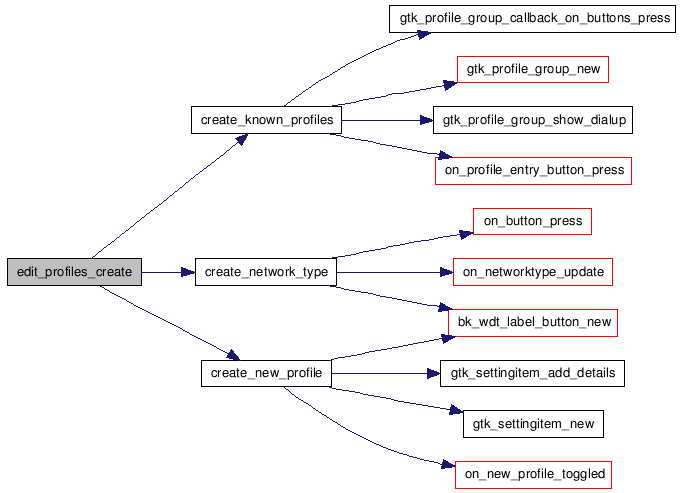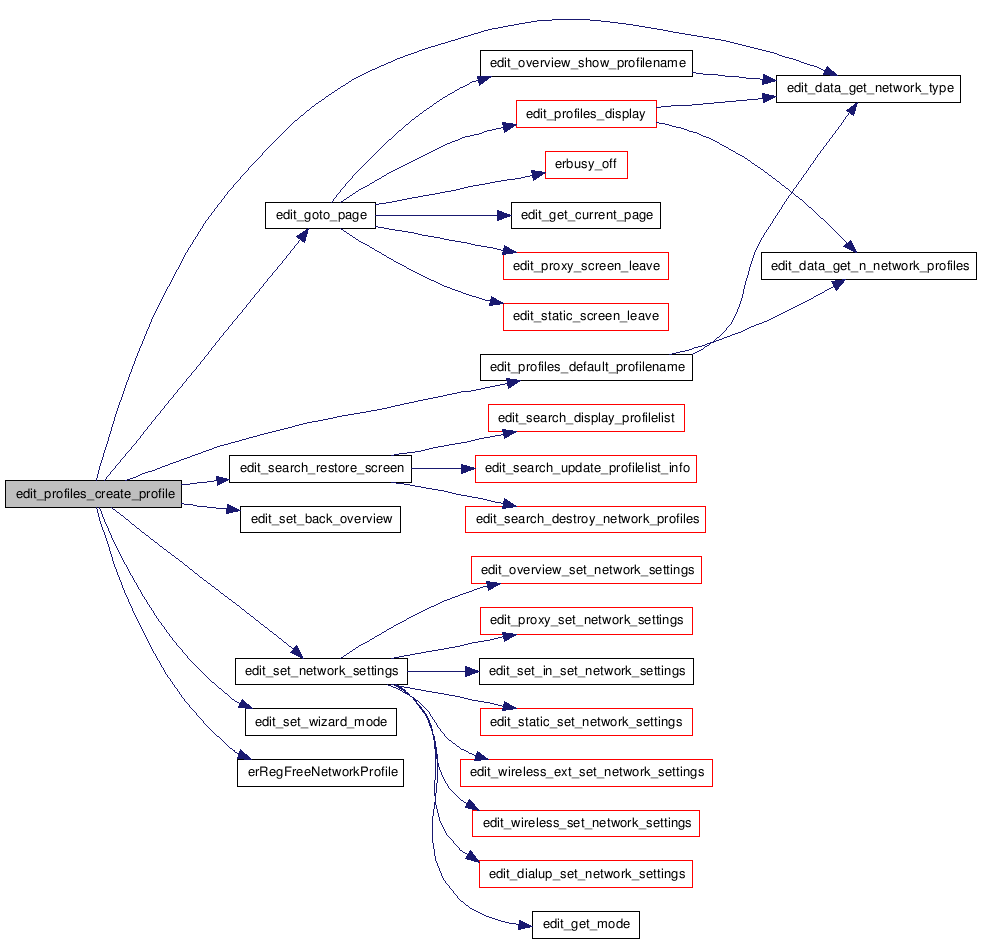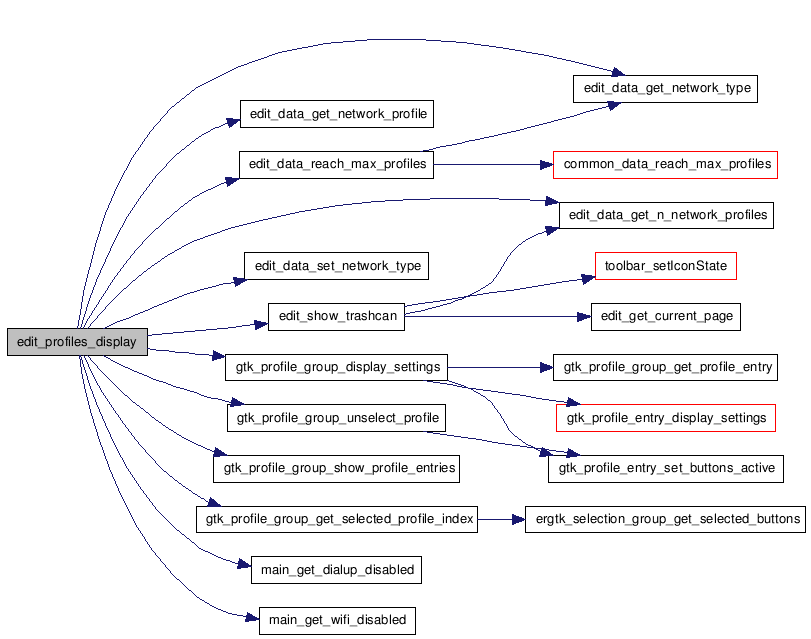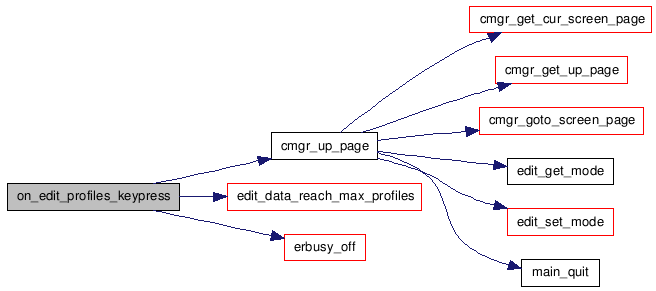connectionMgr/inc/editScreenProfiles.h File Reference
connectionMgr - the first page of 'edit' screen the edit profiles screen containing a selection for network type and a new profile entry and a profile list(registry) More...
#include <gtk/gtk.h>
#include <gdk/gdkkeysyms.h>
#include <glib.h>

Go to the source code of this file.
Defines | |
| #define | ITEM_SELECT_TIMEOUT 6 |
| #define | ITEM_SELECT_TIMER_INTERVAL 500 |
| #define | ITEM_SELECT_TIMEOUT_TICKS ((ITEM_SELECT_TIMEOUT * 1000) / ITEM_SELECT_TIMER_INTERVAL) |
Functions | |
| GtkWidget * | edit_profiles_create (void) |
| void | edit_profiles_set_text (void) |
| void | edit_profiles_display (void) |
| char * | edit_profiles_default_profilename (void) |
| void | edit_profiles_create_profile (void) |
| int | edit_profiles_get_edited_profile_index (void) |
| void | on_edit_profiles_icon_clicked (int iconID, int iconState) |
| gboolean | on_edit_profiles_keypress (GdkEventKey *event) |
Detailed Description
connectionMgr - the first page of 'edit' screen the edit profiles screen containing a selection for network type and a new profile entry and a profile list(registry)Copyright (C) 2007 iRex Technologies BV.
Definition in file editScreenProfiles.h.
Define Documentation
| #define ITEM_SELECT_TIMEOUT 6 |
Definition at line 39 of file editScreenProfiles.h.
| #define ITEM_SELECT_TIMEOUT_TICKS ((ITEM_SELECT_TIMEOUT * 1000) / ITEM_SELECT_TIMER_INTERVAL) |
Definition at line 41 of file editScreenProfiles.h.
| #define ITEM_SELECT_TIMER_INTERVAL 500 |
Definition at line 40 of file editScreenProfiles.h.
Function Documentation
| GtkWidget* edit_profiles_create | ( | void | ) |
Definition at line 127 of file editScreenProfiles.c.
00128 { 00129 CN_LOGPRINTF("entry"); 00130 00131 GtkWidget *vbox; 00132 GtkWidget *networkTypeItem; 00133 GtkWidget *newProfileItem; 00134 GtkWidget *knownProfilesItem; 00135 00136 // vbox 00137 vbox = gtk_vbox_new(FALSE, VBOX_SPACING); 00138 gtk_widget_show(vbox); 00139 g_edit_profiles = vbox; 00140 00141 // networkTypeItem 00142 networkTypeItem = create_network_type(); 00143 gtk_box_pack_start(GTK_BOX(vbox), networkTypeItem, FALSE, FALSE, 0); 00144 gtk_widget_show(networkTypeItem); 00145 00146 // newProfileItem 00147 newProfileItem = create_new_profile(); 00148 gtk_box_pack_start(GTK_BOX(vbox), newProfileItem, FALSE, FALSE, 0); 00149 gtk_widget_show(newProfileItem); 00150 00151 // knownProfilesItem 00152 knownProfilesItem = create_known_profiles(); 00153 gtk_box_pack_start(GTK_BOX(vbox), knownProfilesItem, FALSE, FALSE, 0); 00154 gtk_widget_show(knownProfilesItem); 00155 00156 return vbox; 00157 }

| void edit_profiles_create_profile | ( | void | ) |
Definition at line 645 of file editScreenProfiles.c.
00646 { 00647 connection_t networkType; 00648 regNetworkProfile_t* settings; 00649 00650 CN_LOGPRINTF("entry"); 00651 00652 networkType = edit_data_get_network_type(); 00653 if ((networkType >= 0) && (networkType < connection_undefined_t)) 00654 { 00655 edit_set_wizard_mode(TRUE); 00656 edit_set_back_overview(FALSE); 00657 00658 // get network settings and show in screen objects 00659 settings = g_new0(regNetworkProfile_t, 1); 00660 g_assert(settings != NULL); 00661 00662 settings->name = edit_profiles_default_profilename(); 00663 settings->connection = networkType; 00664 settings->proxy = FALSE; 00665 settings->addressMode = dhcp_t; 00666 00667 edit_set_network_settings(settings); 00668 00669 erRegFreeNetworkProfile(settings); 00670 00671 // show the correct screen 00672 switch (networkType) 00673 { 00674 case wired_t: 00675 edit_goto_page(editScreenOverview_e); 00676 break; 00677 case wireless_t: 00678 edit_search_restore_screen(); 00679 edit_goto_page(editScreenSearch_e); 00680 break; 00681 case dialup_t: 00682 edit_goto_page(editScreenDialup_e); 00683 break; 00684 default: 00685 edit_goto_page(editScreenOverview_e); 00686 break; 00687 } 00688 } 00689 }

| char* edit_profiles_default_profilename | ( | void | ) |
Definition at line 616 of file editScreenProfiles.c.
00617 { 00618 connection_t networkType; 00619 int nProfiles; 00620 char *name = NULL; 00621 00622 networkType = edit_data_get_network_type(); 00623 nProfiles = edit_data_get_n_network_profiles(); 00624 00625 switch (networkType) 00626 { 00627 case wired_t: 00628 name = g_strdup_printf(_("Wired %d"), nProfiles+1); 00629 break; 00630 case wireless_t: 00631 name = g_strdup_printf(_("Wireless %d"), nProfiles+1); 00632 break; 00633 case dialup_t: 00634 name = g_strdup_printf(_("Dial-up %d"), nProfiles+1); 00635 break; 00636 default: 00637 name = g_strdup(""); 00638 break; 00639 } 00640 00641 CN_LOGPRINTF("return %s", name); 00642 return name; 00643 }

| void edit_profiles_display | ( | void | ) |
Definition at line 305 of file editScreenProfiles.c.
00306 { 00307 CN_LOGPRINTF ("entry"); 00308 00309 GtkProfileGroup *profileGroup; 00310 networkProfile_t *settings; 00311 int i, profileIndex; 00312 int nProfiles, nDisplayed; 00313 00314 GtkWidget* widget; 00315 GtkToggleButton* button; 00316 00317 if (g_nwtype_labelbutton) 00318 { 00319 // display choice wired / wireless / dialup 00320 switch (edit_data_get_network_type()) 00321 { 00322 case wired_t: 00323 widget = GTK_WIDGET(g_nwtype_labelbutton->details->buttonList[0]); 00324 break; 00325 case wireless_t: 00326 widget = GTK_WIDGET(g_nwtype_labelbutton->details->buttonList[1]); 00327 break; 00328 case dialup_t: 00329 widget = GTK_WIDGET(g_nwtype_labelbutton->details->buttonList[2]); 00330 break; 00331 default: 00332 // nothing selected (yet), using the default setting: wired 00333 widget = GTK_WIDGET(g_nwtype_labelbutton->details->buttonList[0]); 00334 edit_data_set_network_type (wired_t); 00335 break; 00336 } 00337 00338 // - and select this button 00339 // Note: when the button is already selected, 00340 // we de-select then select again; 00341 // this ensures the signal handlers are called 00342 // regardless the old button state. 00343 button = GTK_TOGGLE_BUTTON(widget); 00344 if (g_first_display && gtk_toggle_button_get_active(button)) 00345 { 00346 // button is selected, so first deselect it 00347 // to make sure signal handler is called 00348 gtk_toggle_button_set_active(button, FALSE); 00349 } 00350 gtk_toggle_button_set_active(button, TRUE); 00351 00352 // Disable buttons for WiFi and/or Dialup based on hardware presence 00353 if (main_get_wifi_disabled()) 00354 { 00355 // set wifi button insensitive when wifi is disabled 00356 widget = GTK_WIDGET(g_nwtype_labelbutton->details->buttonList[1]); 00357 gtk_widget_set_sensitive(widget, FALSE); 00358 } 00359 00360 if (main_get_dialup_disabled()) 00361 { 00362 // set dialup button insensitive when dialup is disabled 00363 widget = GTK_WIDGET(g_nwtype_labelbutton->details->buttonList[2]); 00364 gtk_widget_set_sensitive(widget, FALSE); 00365 } 00366 } 00367 00368 if (g_newprofile_labelbutton) 00369 { 00370 button = g_newprofile_labelbutton->details->buttonList[0]; 00371 00372 // grey out the 'Create new profile' button if needed 00373 if (edit_data_reach_max_profiles()) 00374 { 00375 gtk_widget_set_sensitive(GTK_WIDGET(button), FALSE); 00376 } 00377 else 00378 { 00379 gtk_widget_set_sensitive(GTK_WIDGET(button), TRUE); 00380 } 00381 00382 // deselect the 'create new profile' button 00383 gtk_toggle_button_set_active(GTK_TOGGLE_BUTTON(button), FALSE); 00384 } 00385 00386 // show the corresponding profile entries 00387 profileGroup = GTK_PROFILE_GROUP(g_known_profiles); 00388 nProfiles = edit_data_get_n_network_profiles(); 00389 CN_LOGPRINTF("nProfiles[%d]", nProfiles); 00390 00391 nDisplayed = ((nProfiles < MAX_PROFILES_PER_PAGE) ? nProfiles: MAX_PROFILES_PER_PAGE); 00392 if (nDisplayed > 0) 00393 { 00394 for (i = 0; i < nDisplayed; i++) 00395 { 00396 settings = (networkProfile_t*)edit_data_get_network_profile(i); 00397 gtk_profile_group_display_settings(profileGroup, i, 00398 settings, TRUE); 00399 } 00400 } 00401 gtk_profile_group_show_profile_entries(profileGroup, nDisplayed); 00402 00403 // deselect all profile index 00404 profileIndex = gtk_profile_group_get_selected_profile_index(profileGroup); 00405 if (profileIndex != -1) 00406 { 00407 gtk_profile_group_unselect_profile(profileGroup, profileIndex); 00408 } 00409 00410 // update the trashcan icon as well 00411 edit_show_trashcan(); 00412 00413 00414 g_first_display = FALSE; 00415 }

| int edit_profiles_get_edited_profile_index | ( | void | ) |
Definition at line 691 of file editScreenProfiles.c.
00692 { 00693 CN_LOGPRINTF("entry"); 00694 00695 int profileIndex; 00696 GtkProfileGroup* profileGroup; 00697 00698 if (edit_get_wizard_mode()) 00699 { 00700 profileIndex = -1; 00701 } 00702 else 00703 { 00704 profileGroup = GTK_PROFILE_GROUP(g_known_profiles); 00705 profileIndex = gtk_profile_group_get_selected_profile_index(profileGroup); 00706 } 00707 00708 CN_LOGPRINTF("profileIndex[%d]", profileIndex); 00709 00710 return profileIndex; 00711 }

| void edit_profiles_set_text | ( | void | ) |
Definition at line 245 of file editScreenProfiles.c.
00246 { 00247 GtkWidget *widget; 00248 GtkProfileGroup *profileGroup; 00249 00250 CN_LOGPRINTF ("entry"); 00251 00252 if (g_networktype) 00253 { 00254 gtk_settingitem_set_header_text(GTK_SETTINGITEM(g_networktype), 00255 _("Show network profiles for")); 00256 } 00257 00258 if (g_nwtype_labelbutton) 00259 { 00260 widget = g_nwtype_labelbutton->details->label; 00261 gtk_label_set_text (GTK_LABEL(widget), 00262 _("Select the type of network profiles to list below.")); 00263 00264 widget = GTK_WIDGET(g_nwtype_labelbutton->details->buttonList[0]); 00265 gtk_button_set_label (GTK_BUTTON (widget), _("Wired")); 00266 00267 widget = GTK_WIDGET(g_nwtype_labelbutton->details->buttonList[1]); 00268 gtk_button_set_label (GTK_BUTTON (widget), _("Wireless")); 00269 00270 widget = GTK_WIDGET(g_nwtype_labelbutton->details->buttonList[2]); 00271 gtk_button_set_label (GTK_BUTTON (widget), _("Dial-up")); 00272 } 00273 00274 if (g_new_profile) 00275 { 00276 gtk_settingitem_set_header_text(GTK_SETTINGITEM(g_new_profile), 00277 _("Network profiles")); 00278 } 00279 00280 if (g_newprofile_labelbutton) 00281 { 00282 widget = g_newprofile_labelbutton->details->label; 00283 gtk_label_set_text (GTK_LABEL (widget), 00284 _("Create a new network profile:")); 00285 00286 widget = GTK_WIDGET(g_newprofile_labelbutton->details->buttonList[0]); 00287 gtk_button_set_label (GTK_BUTTON (widget), _("Create new profile")); 00288 } 00289 00290 if (g_known_profiles) 00291 { 00292 profileGroup = GTK_PROFILE_GROUP(g_known_profiles); 00293 gtk_profile_group_set_header_text(profileGroup, 00294 _("Network profiles")); 00295 gtk_profile_group_set_info_text (profileGroup, 00296 _("Stored network profiles on your iLiad: ")); 00297 gtk_profile_group_set_editbuttons_text(profileGroup, 00298 _("Edit")); 00299 } 00300 }

| void on_edit_profiles_icon_clicked | ( | int | iconID, | |
| int | iconState | |||
| ) |
Definition at line 561 of file editScreenProfiles.c.
00562 { 00563 CN_LOGPRINTF("entry iconID[%d] iconState[%d]", iconID, iconState); 00564 00565 on_icon_clicked(iconID, iconState); 00566 }

| gboolean on_edit_profiles_keypress | ( | GdkEventKey * | event | ) |
Definition at line 518 of file editScreenProfiles.c.
00519 { 00520 CN_LOGPRINTF("entry"); 00521 00522 GtkToggleButton *button; 00523 gboolean ret = FALSE; 00524 00525 switch (event->keyval) 00526 { 00527 case GDK_Return: 00528 // 'Enter' key is pressed 00529 // simulate clicking the 'Create new profile' button 00530 if (!edit_data_reach_max_profiles() && g_newprofile_labelbutton) 00531 { 00532 button = g_newprofile_labelbutton->details->buttonList[0]; 00533 gtk_toggle_button_set_active(button, TRUE); 00534 } 00535 else 00536 { 00537 erbusy_off(); 00538 } 00539 ret = TRUE; 00540 break; 00541 00542 case GDK_F5: 00543 // 'UP' key is pressed 00544 // goto the one top level page 00545 cmgr_up_page(); 00546 ret = TRUE; 00547 break; 00548 00549 case GDK_Down: 00550 case GDK_Up: 00551 case GDK_Page_Down: 00552 case GDK_Page_Up: 00553 default: 00554 erbusy_off(); 00555 break; 00556 } 00557 00558 return ret; 00559 }

 1.5.6
1.5.6